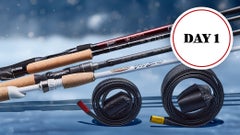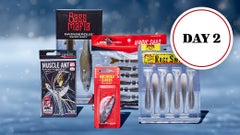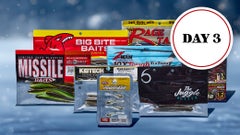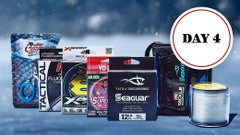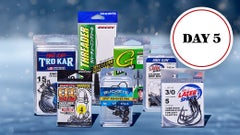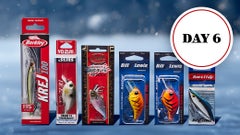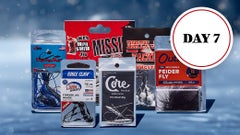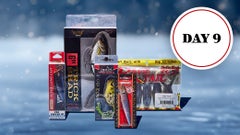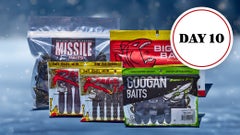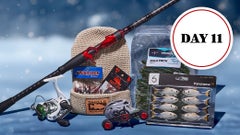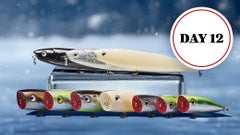BASS Lake St. Clair Baits, Gear & Patterns
Chris Lane's Winning Pattern Baits & Gear
Lane had several factors working against him when practice for the St. Clair event began. For one, he's not a smallmouth ace by any means. For another, he's not extremely well-versed in the dropshotting technique, which was bound to dominate the event. And for a third, he holds a great disdain for the "Miracle Mile," which is the locals' name for the portion of the Detroit River near the Motor City that must be traversed in order to get from St. Clair to Erie. It's actually a lot longer than a mile - like maybe 20 times as long - and the surface boils constantly due to frequent strong winds and the myriad of large boats that use the channel daily. A low-profile bass boat out there can be like a spent mayfly on a mountain stream; it often goes wherever the angry water sends it. Legend has it that the stretch was so named because it takes a miracle to get through there without damage to your boat. The prevailing opinion was that to finish in the Top 12, a competitor would likely have to catch big smallmouths from Erie using a dropshot rig. Under that perceived scenario, Lane's name wasn't the first - or even the 50th - that came to mind. It was his desire to avoid the Miracle Mile, plus the ultra-thin condition of the longest fish on St. Clair, that pointed him in the direction of Lake Huron. From a national tournament perspective, the viability of Huron remained untapped. "I got into the St. Clair River and started fishing around," he said. "I fished cans (buoys), humps, grass, seawalls, docks, just whatever I could find. I worked my way from the bottom of the river all the way up to Huron (a distance of about 50 miles) and I caught a lot of fish, but not a lot of 4-pounders. "As I worked toward Huron, the fish got bigger and bigger and bigger. Then when I got into the lake, I caught a 6-pounder of a buoy that had another one with it. Then I found another buoy that had them. It was phenomenal." Enticing those uneducated bronzebacks into biting something attached to a hook wasn't much of a problem. "They were very easy to catch. Even a guy from Florida could do it."
Competition:
Lane pulled 21 pounds from Huron fairly easily on day 1, then dropped back into the St. Clair River and popped a 5-pounder on a spinnerbait from a baitfish-rich seawall. His sack gave him an early 1 1/2-pound advantage over Davis, who fished more than 100 miles away on a shoal in the middle of Erie. On day 2 he boated a 5-12 off a Huron buoy that equaled his largest specimen of the previous day (that day-1 fish had taken big-bass honors). He didn't get nearly as many bites that day, however, and determined that something (perhaps the cool mornings the area was experiencing) was causing the big ones to relocate. He went farther into the lake on day 3 and caught four solid fish from a series of buoys. He drifted off the last one and eased his way over to a seawall, and there he saw Alton Jones working a current seam in the river. Jones told him the stretch was loaded and invited Lane to come join him. Lane accepted, and they both departed awhile later with premium-quality stringers (Jones' weighed 21-08 and Lane's was about a pound and a half heavier). The spent all of the following day there, this time it was Jones who left with the bigger sack (22-03 to 19-11). Lane's was plenty big enough to secure the win, but compiling it was far from easy as the area almost became a Miracle Mile-type scenario. "I spent a lot of my time trying not to fall out of the boat or sink it," he said. "Imagine a place that's maybe three football fields wide, and there's 50 boats coming at you from one direction and 50 coming from the other direction all the time. "It got so rough that there really wasn't any adjustments to be made at that point. You just have to be physically and mentally prepared for a butt-whipping."
Winning Pattern:
Lane primarily fished a dropshot rig around the buoys and seawalls, but also employed a spinnerbait and a jerkbait. "The key for me with the dropshot was seeing balls of bait holding around the buoys, and I could also see them along the seawalls," he said. "If you found a bunch of bait, you found the smallmouths. They'd bit anything in natural colors that looked like a little minnow or shad." The buoy fish usually came from 18 to 20 feet of water, while the ones relating to the seawalls were 5 to 9 feet down. On the drift he shared with Jones, he drug a tube down 30 feet. It was important to stay along a quasi-mudline where the water went from crystal clear to somewhat dingy. "My Lowrance electronics were important for me because I needed to stay on the contour line," he said. "A lot of guys will use their electronics to see the fish and then just drop down there, but I don't really know how to do that yet. I'd throw out and drift down the line, and sometimes I'd see fish on the graph when I went over them and I knew I should get a bite when my bait got to that spot."
Winning Gear:
Dropshot gear: 7' medium-action All Star AST Drop Shot Abu Garcia Revo SX20 spinning reel, 6-pound Stren Fluorocast line, 1/4-ounce unnamed weight, size 1 unnamed dropshot hook, various 3" and 4" minnow-style plastic baits (natural shad colors).
Tube gear: 7'1" heavy-action All Star AST rod, Abu Garcia Revo Rocket casting reel (9:1 ratio), 15-pound Stren Fluorocast, 3/8-ounce Luck "E" Strike jighead (with rattle), Luck "E" Strike Fast Lane Tube (green-pumpkin/gold). He said the super-high speed of the reel (a new product that will reach store shelves this fall) was critical for that technique. "Dragging a tube with that much line out and with that much wind, you'll almost always have a bow in your line when you go to set the hook," he said. "I'd set and reel and set and reel and set and reel to make sure I got the hook in their mouth."
Spinnerbait gear: 7'1" medium-heavy All Star AST Carolina Rig rod, Abu Garcia Revo SX casting reel (7:1 ratio), 15-pound Stren Brute Strength monofilament, unnamed 3/4-ounce spinnerbait (perch with double willow-leaf copper blades). He doesn't think he weighed any of his jerkbait fish. The bait was a Luck "E" Strike RC Stick (green back/clear).
Main factor: "Fishing with no worries. If I didn't make the Classic at this event, I'd have gone to Okeechobee (for the Bassmaster Wild Card in December) and tried to make it there. If I didn't make it there, I'd have gone to work for the town and my sponsors and come back and started over next year. I'd have been disappointed, but it wouldn't have been the worst thing in the world."
Performance edge: "I'd have to say my Legend/Mercury combo. Counting practice, I drove it about 700 miles, and a lot of those miles weren't real smooth. I never had any issues at all and that thing holds like 62 gallons of gas, so I never had to gas up during the day."
St. Clair Elite Series Winning Pattern Bassfan 8/27/13 (John Johnson)
Mark Davis' Pattern, Baits & Gear
Dropshot gear: 7' medium-action Team Lew's rod, Team Lew's Gold spinning real, 8-pound Seaguar InvizX fluorocarbon line, 3/8-ounce Strike King tungsten weight, size 1 or 2/0 Gamakatsu Split Shot/Drop Shot hook, nose-hooked Strike King Dream Shot (green-pumpkin/gold/purple flake with tail dyed chartreuse) or wacky-rigged 4 1/2" Roboworm Fat Worm (margarita mutilator).
Main factor: "I really had to be diligent in the way I fished every day. I used a lot of patience."
Performance edge: "That's a tie between my Skeeter/Yamaha for getting me there and back and my Lowrance HDS-10 for keeping me around those fish the whole time. I could see them and drop right down on them."
Lake St. Clair Patterns 2-5 Bassfan 8/28/13 (John Johnson)
Alton Jones' Pattern, Baits & Gear
Tube gear: 6'9" medium-heavy Kistler Z-Bone rod, Browning Midas casting reel (6.4:1 ratio), 30-pound Power Pro braided line, 20-pound Seaguar fluorocarbon leader (4'), 3/8-ounce unnamed jighead, 4" YUM tube (green-pumpkin). He said the fish had no reservations about taking a bait attached to such heavy line. "Whenever I get in a situation like that, I always test to see if the fish are line-shy or not, and these were not. I could reel them to the top and fling them to the boat instead of cradling them like I would've had to do with spinning gear."
Main factor: "My first choice would've been to fish Lake St. Clair, but when I saw how skinny those fish were, I knew I needed to look at other stuff. I knew the (fishing) pressure would be going toward Erie, and Erie can take it. The mouth of the St. Clair River can't take a lot of pressure, and I knew it would be less crowded there. It worked out."
Performance edge: "No question, it was my Skeeter FX20. Making those runs with all the wakes and waves was brutal, there's no other way to put it. At age 50, I need a soft ride and that Skeeter delivers it."
Lake St. Clair Patterns 2-5 Bassfan 8/28/13 (John Johnson)
Takahiro Omori's Pattern, Baits & Gear
Dropshot gear: 7'3" medium-heavy Daiwa Black Label casting rod, Daiwa Zillion J Dream casting reel (7.9:1 ratio), 7-pound Sunline FC Sniper fluorocarbon line, 1/2-ounce Kanji International dropshot weight, 1/0 Gamakatsu dropshot hook, Yamamoto Shad Shape Worm (green-pumpkin) or Xzone Fat Slammer (green-pumpkin/copper, purple/blue neon belly).
Tube gear: Same rod and reel, 10-pound Sunline FC Sniper fluorocarbon line, 1/2-ounce homemade jighead, 3 1/2" Yamamoto tube (green-pumpkin). He currently fishes with only baitcasting gear because he has an elbow ailment that's greatly aggravated by using a spinning setup.
Main factor: "I think it was being open-minded during practice."
Performance edge: "My Yahama SHO and Ranger boat held up on that long run with big waves for 4 days in a row."
Lake St. Clair Patterns 2-5 Bassfan 8/28/13 (John Johnson)
Nate Wellman's Pattern, Baits & Gear
Dropshot gear: 6'9" medium-action Cal West Custom rod, Shimano Stradic 2500 spinning reel, 6-pound McCoy fluorocarbon line, 1/2-ounce generic lead dropshot weight, size 1 VMC Spinshot hook, 3" Berkley Gulp! Minnow (black shad) or Poor Boys Erie Darter (mango magic).
Main factor: "Having those places that I've fished for many years. In practice I caught two 4-pounders and a 5 on my main place in the first 5 minutes."
Lake St. Clair Patterns 2-5 Bassfan 8/28/13 (John Johnson)

















